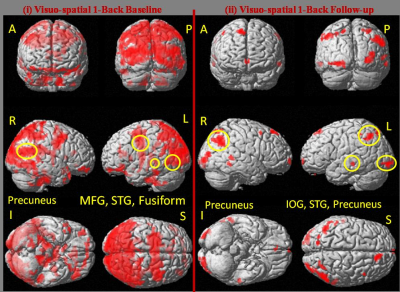4659
Tailored rehabilitation in developmental dyslexia based on neurobiological model1Department of ENT, Escorts Heart Institute and Research Center, New Delhi, India, 2Former Department of NMR and MRI Facility, Former ALL INSTITUTE OF MEDICAL SCIENCES, NEW DELHI, India, 3Department of NMR and MRI Facility, All India Institute of Medical Sciences, New Delhi, India, 4Department of Psychiatry, All India Institute of Medical Sciences, New Delhi, India, 5Department of Neurology, Fortis Hospital, New Delhi, India, 6Department of Psychiatry (Psychology Unit), All India Institute of Medical Sciences, New Delhi, India, 7Department of Linguistics, School of Language, Jawahar Lal Nehru University, New Delhi, India, 8Department of Biostatistics, All India Institute of Medical Sciences, New Delhi, India
Synopsis
Reading a cultural invention by human species is complex cognitive skill. The ventral regions contribute as integrating bottom-up (feed-forward) generic visual processing with top-down influences from phonological and semantic areas. Developmental dyslexia a neurodevelopmental disorder, despite its description since century ago is yet unclear. The heterogeneous deficits, persists and may have emotional-socio-economic consequences. The study shows that if domain specific remediation, tailored according to subject’s neurobiological positive and negative signs along with behavioral measures, it benefits the individuals. Post-training improvement in behavioral performance and reorganizations in neural processing towards normalization, rather than compensatory regions attributed to optimal outcome
Introduction
Reading is an everyday activity important for integrating into the modern society and developmental Dyslexia (DD) is a neuro-developmental disorder with deficits of visual attention, visuo-spatial working memory, executive functions, grapheme-phoneme mapping, auditory-verbal decoding, lexico-semantic, syntactic, comprehension processing, etc [1]. Reading involves complex process and dyslexia comprised of heterogeneous group with similar signs but individual variations [2, 3], making remediation difficult for these deficits. So the intervention needs to be individualized and tailored [4]. If the management is planned based on neurobiological model [5] with task-Functional MRI (fMRI) it may support client-customization for optimized outcomeMethods
The study design was Cross-control interventional. After IEC approval and informed written consent by the parents, children were recruited for pre-therapy assessments. Inclusion criteria for children were: right handedness, children diagnosed with developmental dyslexia (DD), and given written consent. Exclusion criteria were left handedness, any sensory impairment (hearing/ vision), neurological or psychiatric problems, and any contraindication for MRI. The fMRI or Blood oxygen level dependent (BOLD) data was acquired with clinical 3T whole body MR scanner with 32 channel head coil (Achieva 3.0T TX, Philips, Netherlands). Single-shot echo planar imaging (EPI) sequence was used with slice thickness 5 mm, number of slices = 31, TR: 2000 ms, TE: 30 ms, flip angle = 90, and FOV = 230 mm. Paradigms for task-based FMRI were (i) visual-perception, (ii) visuospatial working memory, (iii) phonology (word-pseudoword), (iv) lexico-semantic (nouns), and (v) syntax (sentences). Therapy for 12 DD subjects was tailored as Roger’s client-centered approach [6] by prioritizing domain predominantly affected in the individual subject, based on the BOLD (fMRI) hypoactive areas and tapping potential operating areas. fMRI and clinical performance of DD subject compared with age-gender-matched healthy controls (HC) and literature. Neurorehabilitation sessions were planned thrice a week for initial three months and twice a week for next three months. Post-training outcome with fMRI and clinical performance was investigated after eight months (that is after two-months of completing rehabilitation)Results
The performance on clinical tests was mismatch/ nonconclusive with poor visuo-spatial 1-back fMRI processing and below average performance on arithmetic, digit-span scores (auditory symbolic working memory and manipulation), and very slow copying rate. Good auditory-comprehension, spared performance on visuo-spatial perception, visual discrimination, and conserved visuo-spatial 1-back hit performance score, pictorial visual memory with poor performance on digit span, arithmetic subtests, auditory memory at sentence level and copying rate (Table 1). The elusive performance when corroborated with the fMRI session showed compensatory visuo-spatial 1-back processing recruiting broad and diffused cortical areas (Figure 1(i)). Localized BOLD activity was observed for visual perception and phonological processing. Suggesting poor working memory processing neurobiologically. Thus the intervention was initiated with visuo-spatial scratch-pad interface of phonological-loop (Baddeley Model, 2010) . BOLD activitation for visuo-spatial working memory (1-back) at follow-up was localized to bilateral parietal precuneus, inferior occipital, and superior frontal gyri with right hemispheric dominance. The activity was also observed in left superior temporal and right middle temporal gyri (Figure 1 (ii)). BOLD activation during visual perception (picture completion) was similar at baseline and follow-up sessions confining to bilateral occipital, temporo-parietal and superior frontal areas. Post-remediation the behavioral performance were improved on pattern discrimination, reading comprehension, reading rate, reading errors, spelling errors and writing flow (rate).Discussion
The neurobiological basis help to target the contents of therapy accurately, as only behavioral change might be due to compensatory formation and may improve performance to some extent, but not optimally [7]. Since working memory has dual task holding information and processing execution [8], the improvement generalized to other domains also (holistic academic performance) [9, 10]. Thus the hypothesis of present study evidenced that the therapeutic management when tailored to individualistic basis, reorganizes the neural functions [11]Conclusion
The results document that working memory/cognitive flexibility benefit provided building block for auditory perception, better reading, writing flow, comprehension and scaffolding effect in academic performance. Customizing intervention based on neurobiological model facilitates optimal recovery in developmental dyslexiaAcknowledgements
No acknowledgement found.References
[1] Ring J, Black JL. The multiple deficit model of dyslexia: what does it mean for identification and intervention? Ann Dyslexia. 2018;68(2):104-125.
[2] Norton ES, Beach SD, Gabrieli JDE, 2015. Neurobiology of dyslexia. Current Opinion in Neurobiology SI: Neuropsychiatry (30); 73–78.
[3] Peterson RL, Pennington BF, 2012. Developmental dyslexia. Lancet, 379: 1997–2007.
[4] Law C, Cupples L. Thinking outside the boxes: Using current reading models to assess and treat developmental surface dyslexia. Neuropsychol Rehabil. 2017;27(2):149-195.
[5] Aboud KS, Barquero LA, Cutting LE. Prefrontal mediation of the reading network predicts intervention response in dyslexia. Cortex. 2018 Apr;101:96-106.
[6] Rogers CR, 1951; 2003. Client-centered therapy: its current practice, implications and theory. Ltd: Houghton Mifflin, Boston. New Edition: Contable & Robinson, 2003
[7] Ylinen S, Kujala T, 2015. Neuroscience illuminating the influence of auditory or phonological intervention on language-related deficits. Frontiers in Psychology Cognitive Science, 6; Article 137; 1-9.
[8] Martini M, Furtner MR, Maran T, Sachse P, 2015. Information maintenance in working memory: an integrated presentation of cognitive and neural concepts. Front. Syst. Neurosci., 9; 104. doi: 10.3389/fnsys.2015.00104
[9] Wang S, Allen RJ, Lee JR, Hsieh CE, 2015. Evaluating the developmental trajectory of the episodic buffer component of working memory and its relation to word recognition in children. J Exp Child Psychol., 133; 16-28. doi: 10.1016/j.jecp.2015.01.002
[10] Rotzer S, Loenneker T, Kucian K, Martin E, Klaver P, von Aster M, 2009. Dysfunctional neural network of spatial working memory contributes to developmental dyscalculia. Neuropsychologia, 47(13); 2859-2865
[11] Horowitz-Kraus T, DiFrancesco M, Kay B, Wang Y, Holland SK, 2015. Increased resting-state functional connectivity of visual- and cognitive-control brain networks after training in children with reading difficulties. Neuroimage Clin., 8; 619-630
[12] Baddeley A, 2010. Working memory. Current Biology, 20 (4); R136
Figures


Figure-1 BOLD activation (fMRI) during visuospatial working memory task (i) pre-therapy (baseline), (ii) post-therapy (follow-up)
BOLD activation (important areas marked as yellow circles) rendered on standard template for 1-back visuospatial working-memory processing (p < 0.001, voxel threshold: 10, 1 voxel: 2x2x2 mm3) {A- anterior view; P- posterior; R-right; L- left; I- inferior; S- superior view; MFG-middle frontal gyrus, IFG-inferior frontal gyrus, STG-superior temporal gyrus, IOG-inferior occipital gyrus}